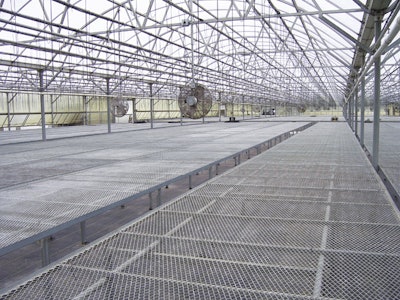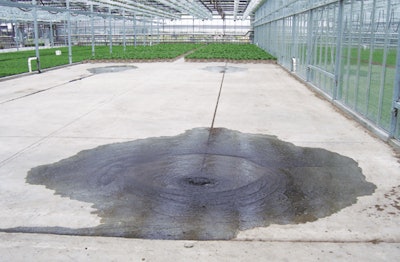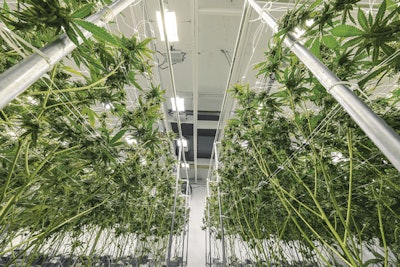
Disease prevention should be a top priority to achieve maximum cannabis yield and the highest-quality product. In addition to a clean growing area, balancing the environmental factors of temperature, humidity, airflow and water is required to help prevent diseases. Here are a few tips growers can use to reduce the disease potential in their cultivation areas.
1. Provide uniform heating.
As most heat sources are either point (unit heater or floor furnace) or linear (bare iron or fin pipe), providing uniform heat throughout the growing area presents a challenge. Natural convection is usually inadequate, and some forced-air movement is necessary. The most cost-effective system for large areas is a horizontal air flow (HAF) system that uses fractional horsepower, large-diameter circulating fans at a rate of 2 cubic feet per minute (cfm)/sq. ft. of floor area. An HAF creates a circular pattern of air flow at 50 feet to 100 feet per minute, which mixes the air from top to bottom in the growing space.
For small growing areas, vertical pattern fans provide good distribution but need to be overlapped to achieve uniformity. These fans draw the cool air from the floor and mix it with the lighter heated air overhead before returning it to the crop area. In addition to temperature uniformity, air movement reduces moisture from leaf surfaces, lowering the disease potential and providing replacement air with a higher carbon dioxide concentration for increased growth. Although more expensive to operate, fan cooling is better than side and roof vents, which are dependent on outside winds.

2. Cover your cooling vents.
To prevent insects and disease organisms from entering the greenhouse, growers should place screens over vents, shutters and other openings. Growers can protect entrance doors to some degree by installing air screens or double-door systems.
3. Respond quickly to humidity spikes.
A humidity level in the 40% to 60% range is standard, except for seedling production, where a slightly higher level is necessary. Excessive humidity levels can occur when irrigation water transpires or evaporates, creating an ideal environment for disease growth, such as powdery mildew, gray mold, Fusarium and Pythium. Ventilation is the standard method for reducing the humidity level in greenhouses because the air outside is drier than it is inside. Even in cold weather, it only costs a few cents to heat the replacement greenhouse air. However, a better system that growers can use to save energy is to incorporate a heat exchanger into the system to capture some of the heat from the moist air and return this to the greenhouse. Spray-on wetting agents for glasshouses and anti-drip additives for greenhouse plastic are other methods that growers can use.
For closed-system/warehouse production, refrigeration-based dehumidification is the standard method. But energy-conserving systems that return the water collected and the heat generated are also available. This system needs to be designed for both lights-on and lights-off conditions as well as the seedling-to-flowering stages. In addition, some growers are using liquid desiccant systems. These move the humid air past a brine solution to absorb the moisture and then heat the solution to regenerate the desiccant.
4. Avoid overhead irrigation.
Water management is another area that is critical for disease control. Overwatering adds moisture from runoff and wet surfaces and increases the need for humidity control. Drip systems and ebb-and-flood benches are an alternative to overhead systems that wet the foliage. Flood floors with hot-water radiant heat in them work well; in addition to providing heat for the greenhouse or warehouse, the heat dries the floor after the water drains back into the tank. This reduces humidity in the lower leaf area, minimizing disease potential.
Much of the water applied through overhead systems never reaches the growing media surface. Wireless base-station monitors that control nodes of multiple moisture sensors are available. Based on light accumulation, evapotranspiration, leachate volume and EC measurement, the nodes open or close solenoid valves in the water supply piping. These systems save water and fertilizer, increase yield and plant quality and reduce labor resulting in a very short payback.

5. Invest in a centralized environmental control system.
Individual equipment control devices (thermostat, humidistat, time clock, etc.) will not help create an environment that will support good production results in either a greenhouse or warehouse facility. Due to the interdependency of temperature, humidity, light, moisture and carbon dioxide, an environmental control (EC) system is necessary to balance these variables. It has the advantage of integrating the operation of different pieces of equipment based on a plant-growth model. The model is designed to take into account many variables, including the plant phenotype and stage of growth, room and equipment layout, projected timing of the crop and many other factors. It also can chart and analyze different growth stages to make future crops easier to replicate. Alarms are available to indicate when environmental conditions are out of established limits. Select a system that has flexibility in the type of equipment that it can control, the ability to make frequent updates to software as well as easy-to-replace components and reliable support service.
6. Limit the size of production zones.
Limiting the size of growing areas can help to reduce or isolate any disease or insect infestation problems that occur. Small zones also allow different environments for the different stages of the growth cycle and more uniform temperature and humidity conditions.
















